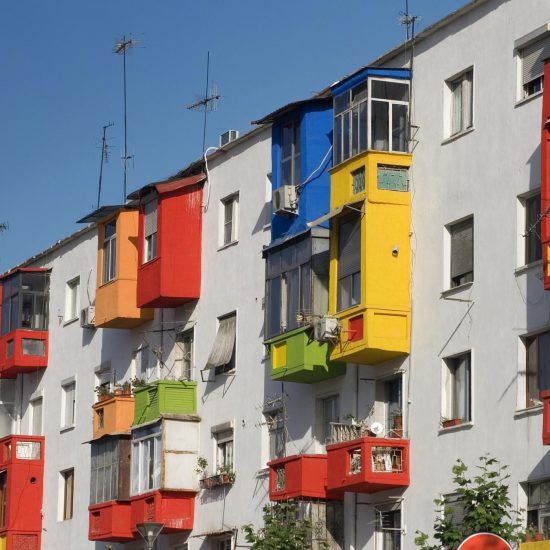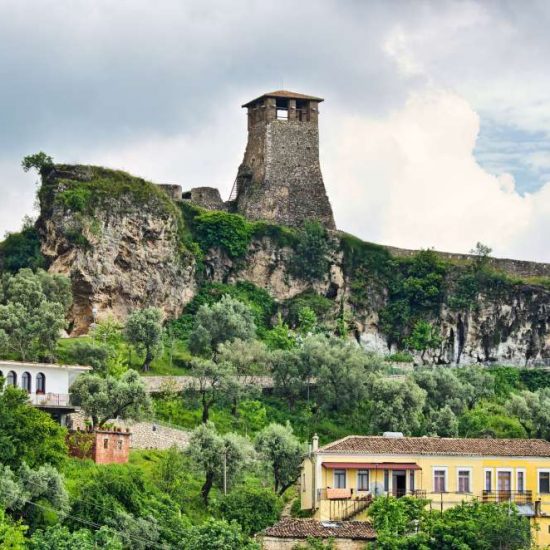Tirana
Tirana, the heart and capital of Albania, like other European metropolises, has endless movement and energy. With its clubs, bars, cafes and taverns, Tirana should be discovered day and night. Hospitality to tourists is what will mark your journey not only in Tirana, but throughout the country.
There are different opinions about the origin of the city’s name. Some think it refers to Tirrenia (a name of Etruscan origin) while others think it refers to Theranda (harvest) or Tirkan (castle at the foot of Mount Datti).
Your own journey can start with a visit to museums and key sites such as Sheshi Skenderbey, where you can see the Ethem Bey Mosque (built between 1798 and 1812) and the 35-meter Kulla-e-Sahatit (Clock). Tower), built in 1822 with a dome in the style of San Marco. Next, you can visit the famous mosaic uncovered on the floor of an old Roman house. Its center forms the walls of the castle of the Roman emperor Justinian (520 AD). Also worth a visit is the monumental tomb of Kaplan Pasha and Ura e Tabakeve (a city built in the early 19th century, located on the Boulevard Jean d’Arc). As the capital, Tirana has the best museums, theaters and galleries of the country, representing the national art. Visit to the National Historical Museum, Archaeological Museum, Natural Museum, the private Mezurai Museum and the National Gallery of Art will leave great memories. You can also spend a pleasant evening at the National Theater or the Opera and Ballet Theatre. For lunch, Tiran offers both rich traditional cuisine and a variety of foreign dishes, from Italian to Chinese and even Indian. Mount Dutty has several clubs and restaurants to discover and enjoy. The mountain can be reached by cable car, which offers a fantastic view of the city. In Tirana, you can also visit the castles of Petrela and Preza, as well as some natural attractions such as Pelumbas Cave, Skalla e Tujanit, etc. Tirana offers both rich traditional cuisine and a variety of foreign dishes, from Italian to Chinese and even Indian. There are several clubs and restaurants on Mount Dutty, to discover and enjoy. The mountain can be reached by cable car, which offers a fantastic view of the city. In Tirana, you can also visit the castles of Petrela and Preza, as well as some natural attractions such as Pelumbas Cave, Skalla e Tujanit, etc. Tirana offers both rich traditional cuisine and a variety of foreign dishes, from Italian to Chinese and even Indian. Mount Dutty has several clubs and restaurants to discover and enjoy. The mountain can be reached by cable car, which offers a fantastic view of the city. In Tirana, you can also visit the castles of Petrela and Preza, as well as some natural attractions such as Pelumbas Cave, Skalla e Tujanit, etc. as well as some natural attractions such as Pelumbas Cave, Shkalla and Tujanit, etc. Tirana offers both rich traditional cuisine and a variety of foreign dishes, from Italian to Chinese and even Indian. Mount Dutty has several clubs and restaurants to discover and enjoy. The mountain can be reached by cable car, which offers a fantastic view of the city. In Tirana, you can also visit the castles of Petrela and Preza, as well as some natural attractions such as Pelumbas Cave, Skalla e Tujanit, etc. as well as some natural attractions such as Pelumbas Cave, Shkalla and Tujanit, etc. Tirana offers both rich traditional cuisine and a variety of foreign dishes, from Italian to Chinese and even Indian. Mount Dutty has several clubs and restaurants to discover and enjoy. The mountain can be reached by cable car, which offers a fantastic view of the city. In Tirana, you can also visit the castles of Petrela and Preza, as well as some natural attractions such as Pelumbas Cave, Skalla e Tujanit, etc. with a fantastic view of the city. In Tirana, you can also visit the castles of Petrela and Preza, as well as some natural attractions such as Pelumbas Cave, Skalla e Tujanit, etc. with a fantastic view of the city. In Tirana, you can also visit the castles of Petrela and Preza, as well as some natural attractions such as Pelumbas Cave, Skalla e Tujanit, etc. such as Pelumbas Cave, Shkalla e Tujanit, etc. with a fantastic view of the city. In Tirana, you can also visit the castles of Petrela and Preza, as well as some natural attractions such as Pelumbas Cave, Skalla e Tujanit, etc. with a fantastic view of the city. In Tirana, you can also visit the castles of Petrela and Preza, as well as some natural attractions such as Pelumbas Cave, Skalla e Tujanit, etc. such as Pelumbas Cave, Shkalla e Tujanit, etc. with a fantastic view of the city. In Tirana, you can also visit the castles of Petrela and Preza, as well as some natural attractions such as Pelumbas Cave, Skalla e Tujanit, etc. with a fantastic view of the city. In Tirana, you can also visit the castles of Petrela and Preza, as well as some natural attractions such as Pelumbas Cave, Skalla e Tujanit, etc.
Kruje
The historic town of Kruja is located on a panoramic mountain slope 32 km from Tirana, at an altitude of 600 m above sea level. The city is one of the most beautiful tourist destinations due to its natural scenery and its history. Here Gerg Kastriot Skanderbeg defended Albania and Europe from the Ottomans. The most important attraction of the city is the Museum of National Hero Gerge Kastriot Skanderbeg, located in the Illyrian Castle, which took on its current facade in the 5th-6th centuries. The castle has nine towers, several houses and Teqja e Dollmasë. Hamm is on the western side of the castle. On the territory of the castle, you can also visit the Ethnographic Museum, a typical house from the mountains, which belonged to the famous Toptani family. Next to the castle is the usual Kruja market. This is one of the largest craft markets in Albania. This market has been operating since the 15th century. There is a religious place called Sari Saltika (Bektashi) on the top of the mountain above the town of Kruya. There, visitors can find shelter and accommodation if they want to climb. From there, travelers have a magnificent view of the valley and further to the Adriatic Sea.
Durres
Durres, where the country’s largest seaport is located, is located 34 km from Tirana. This is the oldest city in Albania with almost 3000 years of history. Its foundation dates back to 627 BC, when the Corinthians and settlers from Corcyra invaded the territory of the Taulantes of Illyria. The city is home to many ancient archaeological sites and finds. The most prominent tourist attraction in Durrës is the 15,000-seat amphitheater of the Roman Emperor Hadrian, the second largest amphitheater in the Balkans. In the 9th century, a small church with walls covered with mosaics was built nearby. You can also see the 2nd century AD baths and the adjacent 5th-6th century Byzantine forum with marble columns. A third of the original wall of the city castle has been preserved, and you can even walk along the same road that Caesar himself once walked along. The Archaeological Museum is housed in a new building on Shesh Taulantia, one of the most important of its kind and of great interest to visitors. The most famous archaeological structure found in Durres is “Bukuroshja e Durrësit”, a mosaic from the 4th century BC. Today it is on display at the National Historical Museum in Tirana. In addition to its historical value, Durres is also a great holiday destination thanks to its sandy beaches, hotels and urban atmosphere. Along the sea coast you will find excellent restaurants and houses. The most famous archaeological structure found in Durres is “Bukuroshja e Durrësit”, a mosaic from the 4th century BC. Today it is on display at the National Historical Museum in Tirana. In addition to its historical value, Durres is also a great holiday destination thanks to its sandy beaches, hotels and city atmosphere. Along the sea coast you will find excellent restaurants and houses. The most famous archaeological structure found in Durres is “Bukuroshja e Durrësit”, a mosaic from the 4th century BC. Today it is on display at the National Historical Museum in Tirana. In addition to its historical value, Durres is also a great holiday destination thanks to its sandy beaches, hotels and urban atmosphere. Along the sea coast you will find excellent restaurants and houses. Today it is on display at the National Historical Museum in Tirana. In addition to its historical value, Durres is also a great holiday destination thanks to its sandy beaches, hotels and urban atmosphere. Along the sea coast you will find excellent restaurants and houses. Today it is on display at the National Historical Museum in Tirana. In addition to its historical value, Durres is also a great holiday destination thanks to its sandy beaches, hotels and urban atmosphere. Along the sea coast you will find excellent restaurants and houses.
Elbassan
Located on the Shkumbin River, where it crosses the famous Via Egnatia, the city of Elbasan – the ancient Scampini – is only 50 km from Tirana. In ancient times, Scampini was a Roman fortification, but in the 4th century it received a new administrative status and with the new name Hiscampis became one of the main cities of the new Epirus, hosting the only Roman legion in the area. According to the historian Titus Livi, the Epirus king Pyrrhus was the first to teach others how to build a camp, so the fortification of the city has the shape of a square. In the 6th century, the city expanded beyond the castle walls to meet the needs of the episcopate, with several cathedrals and a large basilica on Tepe Hill, not far from the castle. In 1466, the Ottomans took control of the Scampini castle and almost completely reconstructed it. They renamed the city to Elbasan, and it became the center of a sanjak (Ottoman administrative region) between the 17th and 18th centuries. This was the heyday of trade both within the country and abroad, which contributed to the significant development of crafts. Today, tourists can visit the Church of St. Mary, the King’s Mosque (inside the city walls), the Naziresh Mosque (very rare because of the female name), the ethnographic museum. There are also two very unique churches in the Elbasan region, painted by Onufri, a famous 16th century Albanian artist. You should go to the villages of Shelkany and Valesh, in the Shpat region. In addition, just 4 km before the entrance to Elbasan, coming from Tirana, there is the monastery of Shen Gen Vladimir. It dates back to 1381 and was built by the Albanian prince Carl Topia, who buried the bones of Saint Gjon Vladimir there. A few kilometers from Elbasan are the llixhat hot springs, which have been in use since Roman times. There you can find accommodation and other amenities.







